
Operation Covering ‘Eagle’
We found ourselves outside the Golden Gate Bridge, bashing through lumpy chop aboard a 45-ft Coast Guard Response Boat-Medium (RBM) packed to the gills with people wearing stock West Marine lifejackets. Through the gray, USCGC Eagle’s tall, slender silhouette became visible. We’d be aboard the tall ship in about 20 minutes.
“Getting out there was half the fun,” my co-worker Nicki Bennett said in an Instagram post. She’d invited former Latituder Mitch Perkins and me on a media tour of Eagle, though I was imagining climbing aboard at the Embarcadero and not at the mouth of the Bay. This sportier, on-the-water version was a welcome upgrade and an adventure unto itself, and it reaffirmed everything Latitude 38 has thought about the Coast Guard — namely, that they’re an exceptional group of people calmly doing extraordinary things.
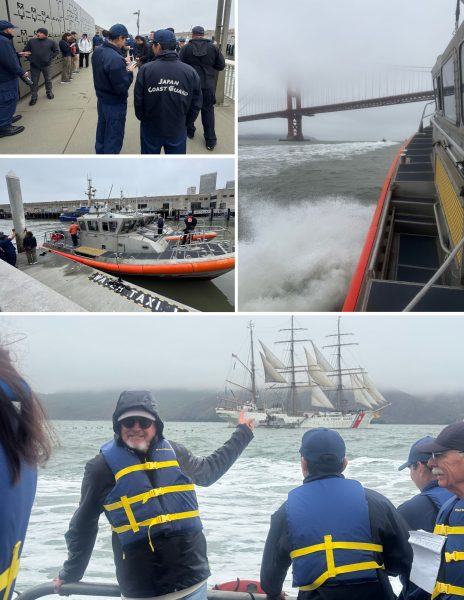
Three Coast Guard boats carrying a total of about 40 people turned toward the inbound Eagle and lined up on the 295-ft barque’s starboard side to load passengers. For a moment, I imagined that we might be climbing a Jacob’s ladder. I was game, but wondered just how sporty this adventure would get. It was no small thing to be bobbing around on a small boat outside the Bay. It was very cold and loud, and salty spray occasionally misted over us.
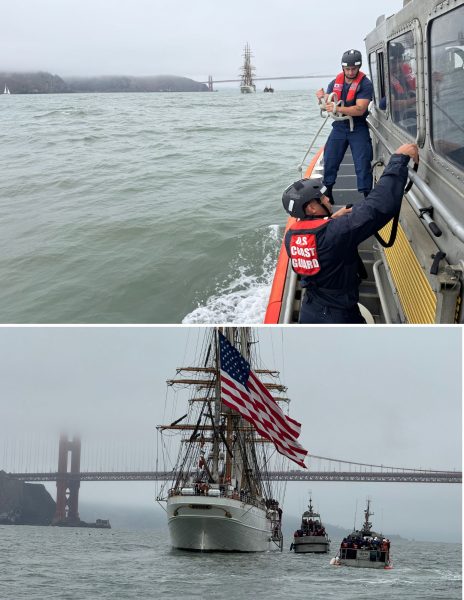
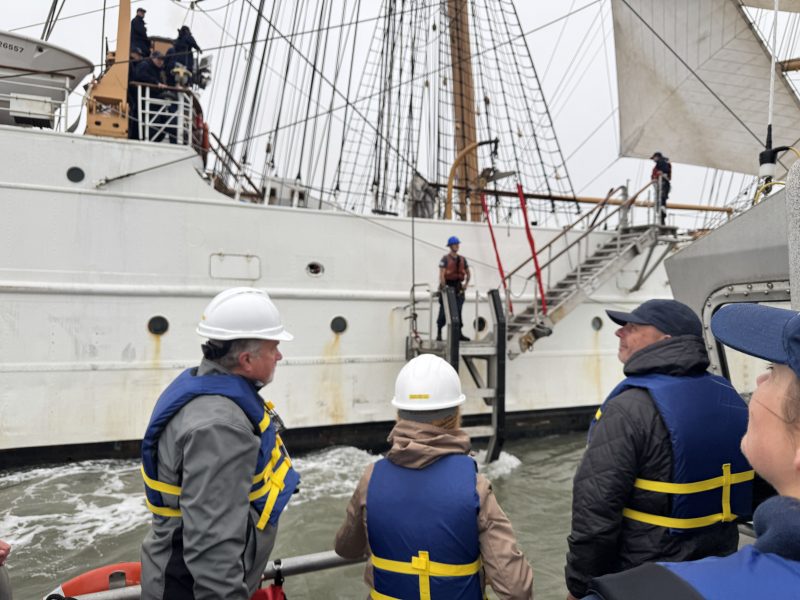
But we were riding with the Coast Guard, after all. Fenders were deployed, the RBM inched closer, and Eagle went from a speck to a hulking ship above us. A proper gangway was waiting. In moments, we were standing on the steady ship. The sudden juxtaposition was stark.
“Welcome aboard,” said a few cadets, some of whom were in their more formal dress uniforms, though most people were in navy-blue utilities. There were perhaps 250 people aboard; it didn’t feel crowded, but it was busy. We were midships, standing in a well between the raised ends of the ship, the Bay barely visible over the bulwarks. We ventured to the bow.
The black Coast Guard cutter George Cobb was on the Bay, two tugboats that would escort us to Pier 15, Matthew Turner under full sail, a handful of small sail and power boats, and the S.F. Fire Department vessel St. Francis firing its water cannons. A Coast Guard Dolphin helicopter circled, at one point flying low enough that you could see its downdraft darkening the water. It felt as though were were standing a few stories above the water.
It was a grand, spectacular scene. I imagined this is how being on a movie set might feel.
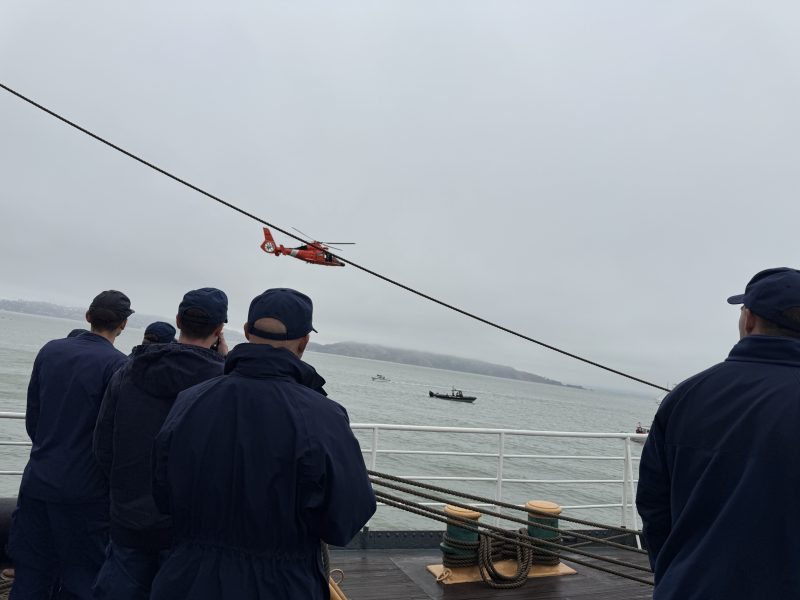
Here’s a how-the-sausage-is-made perspective of what it’s like to “cover” an event. You want to talk with people; you want quotes from individuals and facts about the vessel. But you don’t want to miss the bigger picture. You want to zoom out and watch the operation as a whole, especially on a big ship with a large crew and so many moving parts. Ideally, you can stand back and observe. (Ideally, you’d be embedded and spend a week onboard.) If you’re taking photos, however, you have to anticipate and watch for moments to come together.
I went below to use the head, which turned into its own exciting side quest. I realized that I could have gotten drawn into one of thousands of fascinating microcosms on the ship. I was having FOMO (Fear Of Missing Out). I tried to zoom out.
I was stunned by how young everyone was (which is, of course, a function of growing older), and how … happy the crew were and how much fun they seemed to be having. In that sense, it was similar to the small handful of other tall ships I’ve sailed on. On the bow, sails were lowered and a team of cadets heaved in unison. On the stern, a team of six stood at the three wheels and steered in unison. In the galley, a team washed dishes and prepared food … in unison.
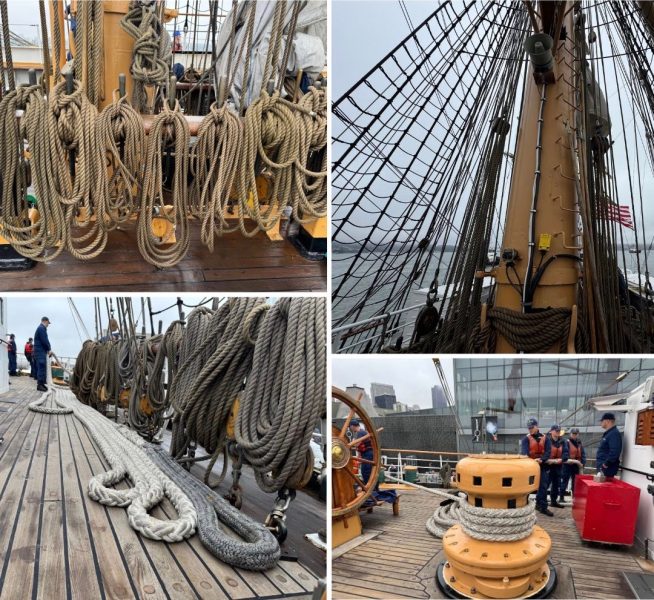
It’s not to say that the Coasties — from the person driving the RBM to the young man in a dress uniform who was essentially serving as a tour guide — weren’t serious about their tasks. There were salutes here and there (it is still the military), but everyone seemed to go about their business with what seemed to be a degree of joy.
“It’s really good to hear that you feel like you were seeing a positive vibe,” Captain Jessica Rozzi-Ochs told me. Rozzi-Ochs sailed aboard Eagle as a young cadet in 1996 and ’97, and became captain of the vessel in 2022. (Today, Capt. Kristopher Ensley relieved her as commander of Eagle.)
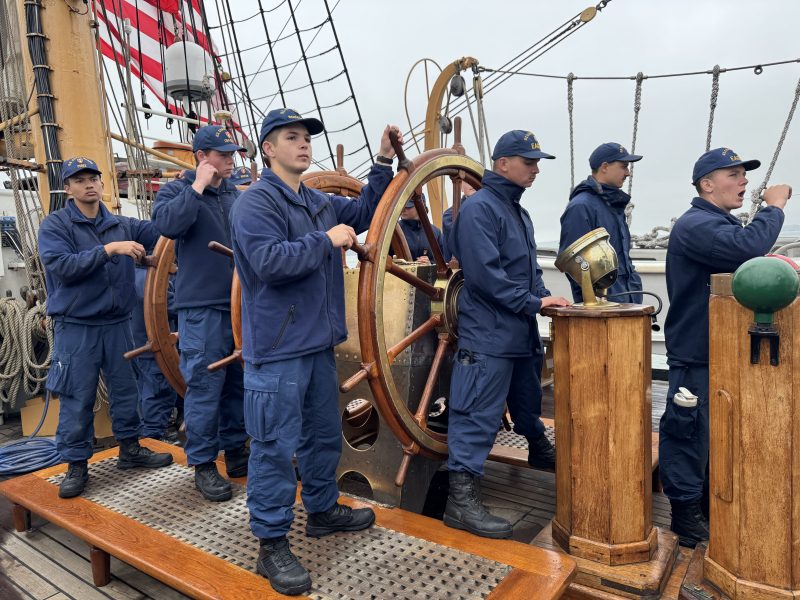
In my experience working as a reporter with the Coast Guard for the past eight years, I’ve noticed what I’ll call an easy competence that seems to pervade what they do. There’s not a lot of fuss; everything is a matter of fact, even what seem to us mere mortals to be incredible feats. Even onboard Eagle, in a training situation where a majority of recruits have never been on a boat, there’s an ease to all the operations. The size of the crew seems to help. Everything, from pulling lines, to moving the gangway to loading ice cream to steering the ship, everything is done with efficient teamwork.
“We have a 60-person permanent crew,” said Capt. Rozzi-Ochs. “They’re the ones that are maintaining the ship 24/7/365. They’re what I consider our instructors. They are teaching the cadets — we have about 140-plus cadets that are on board right now — how to paint, how to chip rust, how to steer the ship, how to do rounds in the engine room, how to climb the rigging; they’re sharing their experience and their passion with the cadets.”

My co-worker Nicki expertly covered the event, shooting video on her phone and putting together clips for a reel that she edited on the ferry back to Marin. She showcased the full experience, from taking the RBMs, to boarding the ship, to the gazillion lines being hauled and tasks being completed. I was thrilled to watch her work. I was thrilled to watch everyone work.
I will admit feeling a wistful yearning to be one of these kids who were part of the crew. The idea of joining the military was terrifying to me as an 18-year-old. I thought I would lose my individuality, but I’m now convinced I would have thrived in this environment and that, as life progressed, the sky would have been the limit.
“We try to empower our younger folks and give them an opportunity to drive the ship without having kind of a safety blanket to make sure that they’re not making mistakes,” Capt. Rozzi-Ochs said.

Note that the Coast Guard Academy is a remarkable education experience for the appropriate sort of student and is certainly affordable as well. It grants fully accredited bachelor’s degrees in a wide range of subjects, including engineering and science and is highly ranked by the various college guides. It is an opportunity that young people should investigate to see if it fits them. http://www.uscga.edu for more information. (No, I went to UC Berkeley.)
Great article Tim! Thanks for the invitation Nicki. What an outstanding day. Keeping the tall ship tradition alive seems more important than ever. Thank you Coast Guard.
Nice writing, Tim. Very well done. Your approach from a different perspective was great!
I LOVE this ! I have been following the Eagle since she became the training ship for the CG. There is a fantastic book called ” The Skipper and the Eagle”, which documents her departure from Germany after WWII and her restoration.